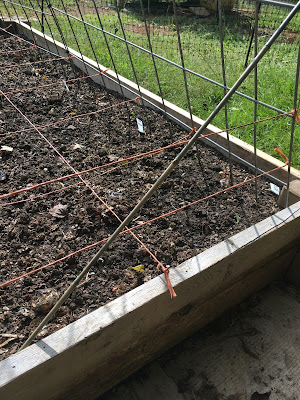It's the first official Garden Friday of autumn!
Welcome to our humble homestead.
Recently, I had found this chrysalis hanging on a blade of fountain grass.
Yesterday, when I checked on it again
this was the sight that awaited me.
C and I moved the pot underneath the eaves,
as the weather was predicted to get even rainier,
and it looked like it wasn't yet ready to fly.
It must have eventually dried its wings enough,
because by suppertime, it was gone.
Have a beautiful life, you amazing thing you.
This week I found myself at Lowe's drooling over the pansies.
I love this time of year when I can replace the faded flowers
and add this vibrant pop of color everywhere.
The front porch beds have been filled and our mailbox planter
has been planted with a smattering of these beauties.
I may have gone overboard and bought a few too many,
but there is always a neighbor with whom to share
a few extra blooms.
The snap peas are looking good,
and with yesterday's (and today's) rainfall,
they should be mighty happy to climb the cattle panel.
The three 3X4 beds were put together this week
and divided up using baling twine that came from straw bales.
I inserted nails every foot and stretched the baling twine across the beds,
both vertically and horizontally.
This not only keeps my planting area defined,
but acts as a bit of a chicken-proofer to keep them out of the beds.
Taking advantage of a cool evening, sowing was done in the 3 new beds,
as well as the 3X8 bed already in place.
It feels good knowing I have most of the fall crops in.
I still plan to sow some containers,
and will try to get to that by this weekend.
I'll just slide in my self-imposed deadline of
having the fall garden planted by October 1st.
The new boxes contain beets, broccoli, cabbage, chard, kale,
leek, lettuce, parsley, spinach, and tat soi.
In the space that used to be the garden,
we decided to overseed with White Dutch Clover.
This will be a pollinator haven and may give the chooks
some extra foraging space.
We also have a lot of wild rabbits in the neighborhood
who will no doubt find it enticing.
Another purpose for the ground cover
is to help absorb moisture, as this is our drain field.
I simply spread the seed by hand and let the rain do the rest.
This black-eyed Susan vine is a volunteer that is spreading nearby.
It was originally planted in straw bales,
when we had some veg growing in them as well.
It'll make a gorgeous ground cover and be another way
to attract pollinators to our yard.
The tithonia is starting to take off and we're lovin' it!
This is one of my all-time favorite blooms.
It germinates easily, has abundant blossoms
and stays around for a good, long while.
Our summer and fall garden will never be without it.
With most of the bigger garden projects completed,
it's time to focus on mulching the garden
and getting the irrigation installed.
There is always something to do!











































